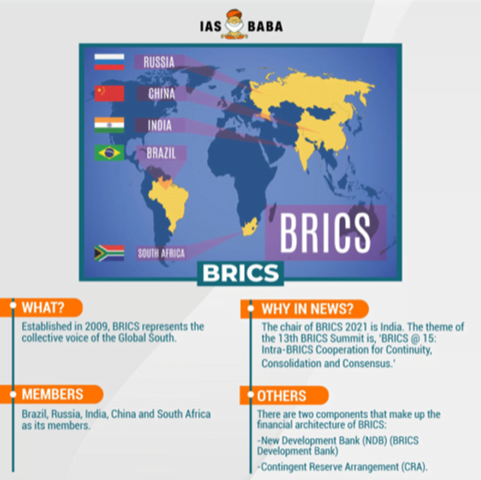UPSC Articles
13th BRICS summit
Part of: Prelims and GS – II – International Relations
Context The 13th BRICS summit was held virtually.
- The virtual summit was chaired by a Indian Prime Minister and was dominated by the developments in Afghanistan
Key highlights of the summit
- The summit adopted the BRICS Counter Terrorism Action Plan.
- The document, titled the New Delhi Declaration was unveiled which called for addressing the humanitarian situation in Afghanistan, and urged the need to uphold rights of women, children and minorities.
- It called for an “inclusive intra-Afghan dialogue” to ensure stability, civil peace, law and order in the country.
- The agreement on Remote Sensing Satellite Constellation was signed between BRICS countries’ space agencies.
What is BRICS?
- BRICS is an acronym for the grouping of the world’s leading emerging economies, namely Brazil, Russia, India, China and South Africa.
- Headquarters: Shanghai, China
- The BRICS Leaders’ Summit is convened annually.
- The Chairmanship of the forum is rotated annually among the members, in accordance with the acronym B-R-I-C-S.
- Together, BRICS accounts for about 40% of the world’s population and about 30% of the GDP (Gross Domestic Product), making it a critical economic engine.
- Objectives:
- To deepen, broaden and intensify cooperation for more sustainable, equitable and mutually beneficial development.
- To ensure relations are built on the respective country’s economic strengths and to avoid competition where possible.
- Components of financial architecture of the BRICS:
-
- New Development Bank: NDB’s key areas of operation are clean energy, transport infrastructure, irrigation, sustainable urban development and economic cooperation among the member countries.
- Contingent Reserve Arrangement: It aims to provide short-term liquidity support to the members through currency swaps to help mitigate the BOP crisis situation and further strengthen financial stability.

News source: TH













